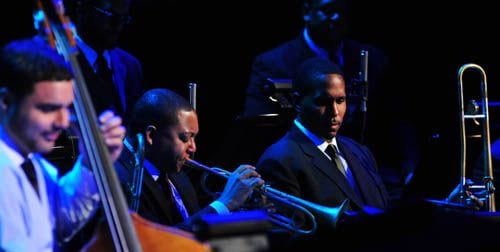
As America gradually wakes up to the generational shift taking hold of it, jazz music continually seems displaced to its fringes, a marginal art form constrained by time and esoteric musical intellectualism. In other words, it’s old and elitist. Though jazz is equally, if not more, fundamental to the American psyche as baseball, we, unfortunately, don’t pay our dues as devoutly as to those on the diamond. Composer and pianist Thelonious Monk, sitting among the top of Jazz’s deities, is an apt place to begin. Never one for speaking much, his erratic and recluse behavior made him a notorious yet respected player in his own time. But today, outside of the jazz world, he is largely ignored despite his monumental contributions. Look no further than to Late Night with Conan O’Brien’s opening montage to hear a Monk composition (“Epistrophy”), as performed and arranged by the Max Weinberg 7. Jazz at Lincoln Center, though, is desperately, and quite admirably, trying to revive jazz’s precipitous decline into popular obsolescence with programs like “The Music of Thelonious Monk” — one of a handful of programs during the center’s Monk Festival, leading off the 2008-2009 season’s Hall of Fame series. Featuring the preeminent interpreter of Monk’s repertoire, and frequent collaborator and former protégé of orchestra director Wynton Marsalis, pianist Marcus Roberts was the instrumental bedrock of the evening’s set. By both paying tribute to the past and reinventing it Roberts has quickly become an icon of contemporary traditional jazz. Beginning, and enveloping, the entire program was an irritating and melodramatic Thelonious Monk narrative, as read by actor Courtney Vance. The opening paragraph introduced Monk as a “weird”, “unusual”, and “unprecedented” figure while the Jazz at Lincoln Center Orchestra (JLCO) played a quiet mid-tempo vamp beneath. It was an entirely unnecessary exercise that disrupted and distracted from the natural ebb and flow of Monk’s compositions. Instead it dawdled, Vance trying to get a laugh after each an-nun-cia-ted line. As artistic director of the JLCO, Marsalis is the natural leader. However the program featured arrangements of Monk’s music by several members of the group, showing off its flexibility and range. “Bye-Ya”, arranged by bassist Carlos Henriquez, quickly established a Latin rhythm that found its way into an earlier piece as well. Alto saxophonist Ted Nash elongated the more dissonant aspects of Monk’s writing in his “Skippy” solo, while the rest of the piece respired via the saxophones. On “Epistrophy” Chris Crenshaw (trombone) chose to emphasize the beat, a heavy hip-hop feel percolating the piece. Its challenging phrasing and, at times, dissonant melody were reprised in several trumpet solos after being carried initially by the saxophones. The beautiful “Crepuscule with Nellie” — written for his dedicated wife — was so meaningful to Monk, Vance informed the audience, that he never allowed anyone else to solo over it. Interestingly, the orchestra dwelled heavily on the romantic inclinations of the piece prompting sultry sounding saxophones that came off a bit schmaltzy. Likewise, wah-wah filled trombone lines enhanced the cheap romantic vibe. It was an unusual direction to take the piece because for me it always connoted a distinctly devoted, sincere and loving emotion. The night’s best-received selections were “Ba-lue Bolivar Ba-lues-are” and “Blue Monk”. This wasn’t a complete surprise as both are affable, blues-derived pieces with less apparent melodic meandering than some of Monk’s denser bop compositions. On “Ba-lue Bolivar Ba-lues-are”, trumpet player Freddie Hendrix took an expansive solo with the crowd really responding to his colorful playing and bop flourishes. “Blue Monk”, on the other hand, belonged entirely to Roberts. He dug into the piece, brandishing deep boogie woogie grooves by the time he was soloing, provoking the crowd into shouts and hollers. Rounding out the program, “Four in One” again showcased Roberts’ dexterity at the keyboard and his idiosyncratic reinterpretations of Monk’s trademark rhythm and harmonic structures. Marsalis, always the demure showman, seemed to have saved his best for last, blasting an incredible solo with Gillespie-esque range and bravado and then dissolving it into swinging New Orleans jazz lines before taking more unexpected twists and turns. As brilliant as Roberts is, my only criticism is that he seems physically incapable of conveying the, all-important, visceral element of Monk’s playing. It speaks as much to Monk’s uncompromising singularity as to his physically ominous presence at the piano. However, in the big band format, the orchestra was capable of injecting the force, emphasis and emotion that Monk himself could so easily strike out from the keyboard with equal touch and finesse.

![Call for Papers: All Things Reconsidered [MUSIC] May-August 2024](https://www.popmatters.com/wp-content/uploads/2024/04/all-things-reconsidered-call-music-may-2024-720x380.jpg)



